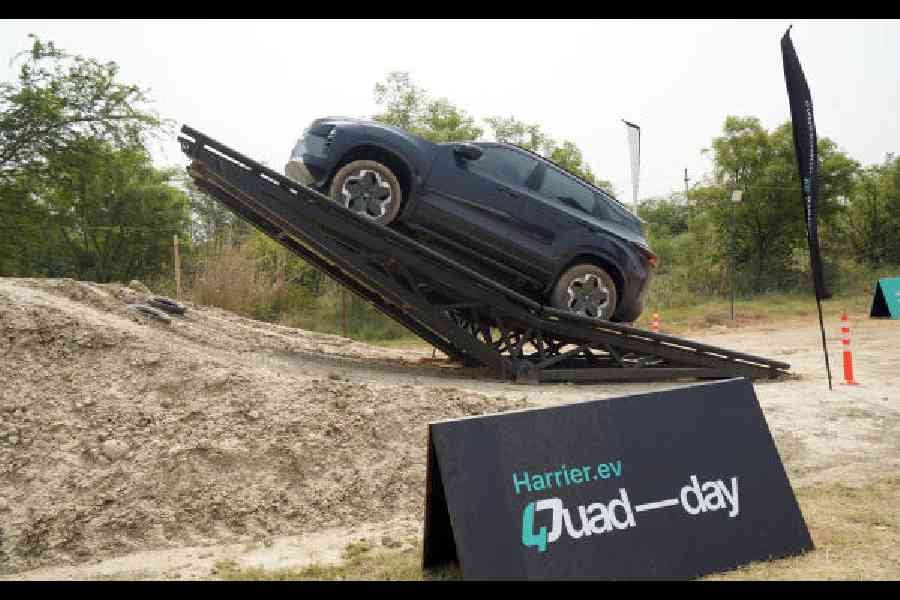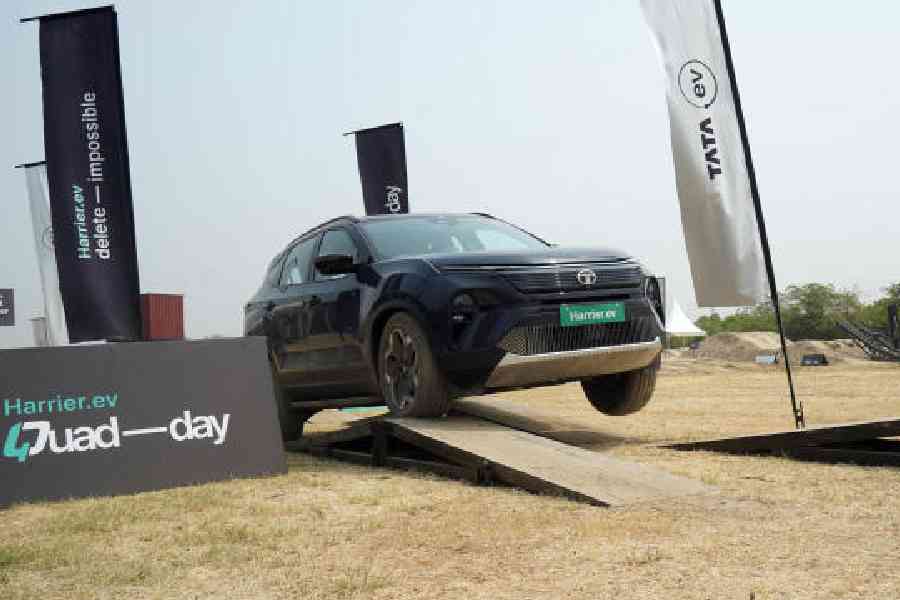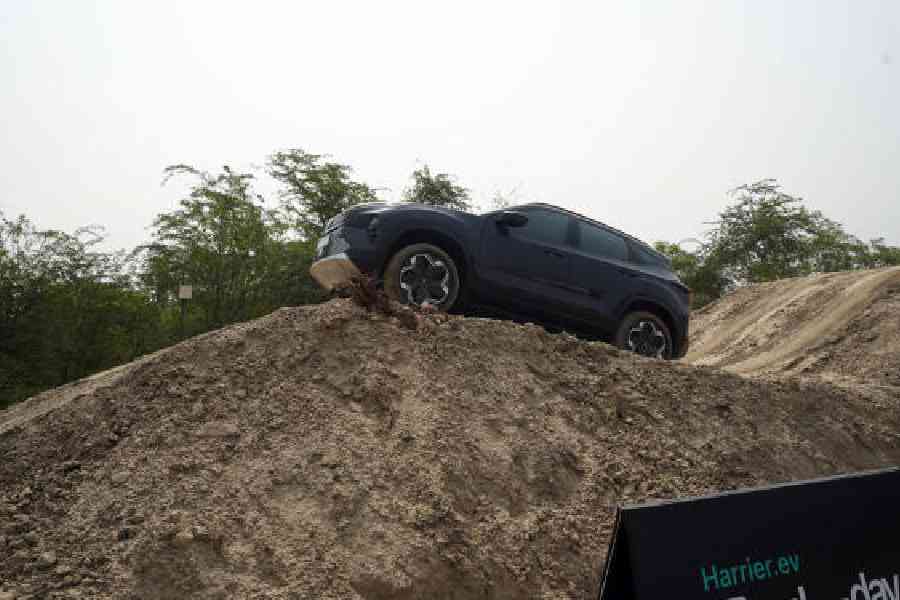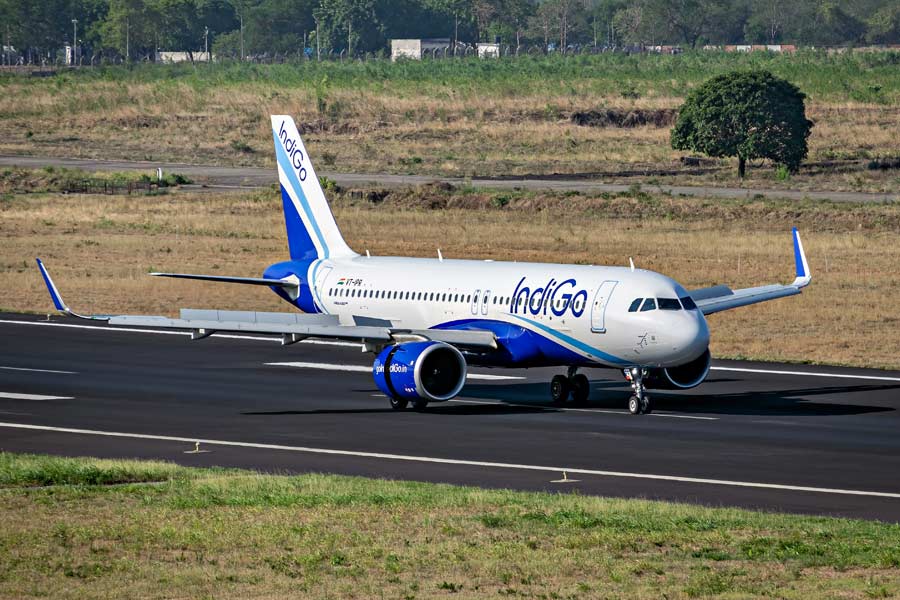Tata Motors’s Tata Passenger Electric Mobility (TPEM) has much riding on the new Tata Harrier.ev. For one, it appears to be the company’s answer to the whole bunch of EVs in the ₹20 lakh to ₹30-lakh price segment. While its Curvv.ev covered the early twenties, there was nothing further up. Second, it also needs to reinforce TPEM’s cred in higher priced segments to, possibly, open them up for more upmarket offerings that can happily go beyond the everyday requirements and be go-anywhere vehicles. So, the manufacturer was out to prove its claims.
Okay, a confession first. When we drive new cars, we hate to get into regimented routines and would much rather experience the vehicle our own way. Sometimes, however, planned programmes that demonstrate the capabilities of a vehicle under specific circumstances do have their merit. Our experience of the just-introduced Tata Harrier.ev last week at the Buddh International Circuit (BIC) in Greater Noida at TPEM’s invitation was one of them.

The see-saw ramp gives its share of thrills
TPEM is plugging the Harrier.ev as an off-roading, quad wheel drive EV with a driving range of over 620km on a single full charge under test conditions, whether one goes for the rear wheel drive version with a 65kWh battery or the quad wheel drive version with the 75kWh battery. In real life situations that should translate to 500km-plus is our guess. But that’s not what the experience TPEM had planned to give. It had lined up three kinds of activities — off-roading, speed runs and ADAS (Advanced Driver Assistance Systems) demonstrations.
What we were driving or were being driven in as the case may be was the Harrier.ev in the dual motor version. This has a 175kW (about 235hp) motor driving the rear wheels and a 115kW (about 154hp) motor driving the front ones. The combined peak power output is 260kW (about 349hp) and combined peak torque is 504Nm. This maximum power output comes when the vehicle is put in the Boost mode and can be activated as long as the battery has 50 per cent or more of charge left. The button to activate Boost, incidentally, comes with a little rocket symbol! When the vehicle is not in the Boost mode, the maximum power available is 200kW (about 268hp) and maximum torque is 470Nm. In this dual-motor configuration, the vehicle weighs around 2,330kg. So, yes, all this power and torque is needed.
OFF-ROADING
To prove the Harrier.ev’s off-roading chops — this is important since its maker is using this aspect to differentiate itself from the rest of the EVs in its market segment — TPEM had set up a sort of an obstacle course laid out with various kinds of surfaces and inclines and declines. This SUV comes with various terrain settings — tarmac/Normal, Snow/Grass, Mud/Slush, Sand, Rock, and Custom. It also has drive modes Eco, Sport, and Boost, apart from Normal.
First off, we drove into the flat loose rock stretch that it handled without flinching. The vehicle was set to crawl mode at 6kmph and it needed no further brake or throttle inputs to cross the rocky bit. What impressed us right there, though, was the ride quality. Apart from a bit of mild shake, we almost did not feel that the vehicle was going over loose broken stones. Just prior to that the vehicle had been driven through a water wading pit to prove its ability to drive through 60mm of water. Also on demonstration was a Harrier.ev body shell with 1.5 tonnes placed on its roof to show the strength of the structure.

In Quad Wheel Drive, three wheels in contact with the ground are good enough to pull the Harrier.ev through
After the rocks came a proof of wheel articulation where one of the wheels kept going up in the air leaving the other three to create the traction to pull the SUV through. Up next was the demonstration of the vehicle’s ability to climb a 34° incline and go down a 35° decline. Oh the way up was the show of Hill Hold Assist, where, should one have to stop, the Harrier.ev will hold the brakes for three seconds before allowing the car to roll down, and it does. This was dispatched pretty easily and one just needed to approach it at around 10kmph and hold onto the accelerator pedal. The brakes worked quite well on the decline considering that they were dealing with over 2.5 tonnes of weight.
All this while the 540° display was on and showed the terrain below the SUV and exactly what kind of surface the wheels were going over. This was particularly useful when we crossed a narrow bit with ramps only for the wheels. All this was happening in the Mud/Slush mode to check wheel spin. Also, this whole thing was happening in the Boost mode that made all 504Nm of torque available all along.
Sand mode and a stretch of sand was next up and was again dealt with smoothly, no wheels digging in, no sand thrown up. There might have been some earth surface a bit below the sand that might have given some stability, but good on the whole.
A tipping ramp led up to a series of camelback humps that again showed the fairly high approach, departure and breakover angles. Unless one is doing some serious off-roading, it is unlikely that one will have to deal with anything like this. Back to Mud/Slush, a stretch of watery-muddy track was taken in the stride although with some loss of traction in the rear and a bit of fishtailing
Finally, we were off to tackle a simulated super-tight mountain turn that needed a climb and a decline with a couple of reverses in the middle to get the Harrier.ev’s nose pointing the right way. It’s in situations like this that you learn to trust spotters because you can’t see where you’re going and falling off could end up in injury. This obstacle, too, was done quite nicely and descent was controlled although it was quite slippery.
We were pretty impressed with the way the Harrier.ev had handled the obstacles. The wheel articulation isn’t as much as it would be in a hardcore 4x4, but short of that it is likely to give drivers the impression that they are way better at off-roading than they actually are. Both the electronics and mechanicals are impressive and TAPM says that it is an entirely new system that it has developed in-house. Good job, we must say.
SPEED RUNS
The back straight of the BIC is fast. We got a taxi ride in the Harrier.ev and on that stretch it hit about 170kmph. We are told that the maximum speed of this EV has been fettered to 180kmph. So it was pretty close. Handling through the circuit was poised and around 85kmph on the long sweeping curve at the far end it felt like we could lose the SUV if it went any faster. That’s the problem with physics that taller vehicles cannot overcome, notwithstanding the fact that the low placement of the battery helps with grip.
The Harrier.ev is quick on paper and to check it was a run along the start-finish straight at the BIC. We did not time it with a stopwatch or anything, but flooring the accelerator at standstill gives the vehicle a run that’s plenty plenty quick for sure, although the surge is very linear and there isn’t a lot of that initial kick-in-the-back feeling.

At both high and low speeds the vehicle brakes itself if it perceives a pedestrian in front
But for an SUV that’s expected to do all sorts of things, this was a pretty good show.
ADAS
This is fast becoming a pretty standard feature in cars and the Harrier.ev has it as well — ADAS. It does a whole battery of things, but we’ll talk about the higher capability bits first. So, the Harrier.ev can park itself, either parallel or perpendicular to the kerb. It does the entire operation without any driver input. In fact, Sam, who was giving us the demo, got out of the car and stood outside while the Harrier.ev was parking itself. It shuts down by itself to boot once the job is done.
The other interesting bit was inside a simulated flea market with a narrow access. Once driven in, the Harrier.ev reversed itself out of this space smoothly and without any driver input at all whatsoever. It appears it can remember what it has done for the last 50m and can retrace the exact line to extricate itself.
This apart, it does emergency stops at high and low speeds if a pedestrian suddenly comes in front of the car. It has adaptive cruise control to adjust to the speed of the vehicle in front or overtake it if moved to another lane. Then there’s the usual lane keep assist and lane departure warning and so on.
Our first feel of the Tata Harrier.ev in the metal and in motion was pretty good and we were impressed with the off-roading capabilities. Even if not off-roading, it would be quite assuring to know that the Harrier.ev can get you out of sticky situations that other SUVs might not be able to. We liked what we saw and felt. However, as we said at the outset, this entire exercise was done in controlled conditions. We are hoping to get our hands on one to drive it around on public roads and figure out what it’s like to live with. But that will be the story for another day.











